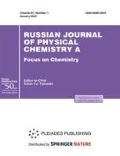Abstract
The dependence of a sensor’s response to hydrogen on the temperature and hydrogen pressure in an indium oxide nanostructured film is measured. A theory of sensor’s response to reducing gases in nanostructured semiconducting oxides with high concentrations of electrons in the conduction band is developed (using the example of In2O3). It is shown that the capture of conduction electrons by adsorbed oxygen redistributes the electrons in nanoparticles and reduces the surface electron density and the conductivity of a system; the conductivity is proportional to the electron density in nanoparticle contacts, i.e., to the surface electron density. It is found that atomic oxygen ions react with reducing gases (H2, CO) during adsorption of the latter: electrons are released and enter the volumes of nanoparticles; the conductivity of the system grows, creating the sensory effect. Using a model developed earlier to describe the distribution of conduction electrons in a semiconductor nanoparticle, a kinetic scheme corresponding to the above scenario is built and corresponding equations are solved. As a result, a theoretical dependence of a sensor’s sensitivity to temperature is found that describes the experimental data well.
Similar content being viewed by others
References
W. Gopel and K. Schierbaum, Sens. Actuators B 26, 1 (1995).
Y. Shimizu and M. Egashira, MRS Bull. 24, 18 (1999).
N. Yamazoe, Sens. Actuators B 108, 2 (2005).
G. Korotcenkov, Mater. Sci. Eng. B 139, 1 (2007).
N. Yamazoe and K. Shimanoe, Sens. Actuators B 138, 100 (2009).
C. Xu, J. Tamaki, N. Miura, and N. Yamazoe, Sens. Actuators B 3, 147 (1991).
D. E. Williams, Sens. Actuators B 57, 1 (1999).
F. Lu, Y. Liu, M. Dong, and X. P. Wang, Sens. Actuators B 66, 225 (2000).
A. Rothschild and Y. Komem, J. Appl. Phys. 95, 6374 (2004).
G. Korotcenkov, Mater. Sci. Eng. R 61, 1 (2008).
N. Barsan and U. Weimar, J. Phys.: Condens. Matter 15, R813 (2003).
D. Kohl, J. Phys. D: Appl. Phys. 34, R125 (2001).
K. Schierbaum, U. Weimar, W. Gopel, and R. Kowalkowski, Sens. Actuators B 3, 205 (1991).
M. A. Kozhushner, V. L. Bodneva, and L. I. Trakhtenberg, Russ. J. Phys. Chem. A 86, 1281 (2012).
M. A. Kozhushner, L. I. Trakhtenberg, A. C. Landerville, and I. I. Oleynik, J. Phys. Chem. C 117, 11562 (2013).
M. A. Kozhushner, L. I. Trakhtenberg, V. L. Bodneva, et al., J. Phys. Chem. C 118, 11440 (2014).
V. F. Gromov, G. N. Gerasimov, T. V. Belysheva, and L. I. Trakhtenberg, Russ. J. Gen. Chem. 79, 2024 (2008).
L. I. Trakhtenberg, G. N. Gerasimov, V. F. Gromov, et al., Sens. Actuators B 169, 32 (2012).
C. Malagu, V. Guidi, M. Stefancich, et al., J. Appl. Phys. 91, 808 (2002).
N. P. Zaretskiy, L. I. Menshikov, and A. A. Vasiliev, Sens. Actuators B 170, 148 (2012).
M. A. Kozhushner, B. V. Lidskii, I. I. Oleynik, et al., J. Phys. Chem. C 119, 16286 (2015).
L. I. Trakhtenberg, G. N. Gerasimov, V. F. Gromov, et al., Sens. Actuators B 187, 514 (2013).
L. I. Trakhtenberg, G. N. Gerasimov, V. F. Gromov, et al., Sens. Actuators B 209, 562 (2015).
T. V. Belysheva, A. K. Gatin, M. V. Grishin, M. I. Ikim, V. M. Matyuk, S. Y. Sarvadii, L. I. Trakhtenberg, and B. R. Shub, Russ. J. Phys. Chem. B 9, 733 (2015).
Author information
Authors and Affiliations
Corresponding author
Additional information
Original Russian Text © M.A. Kozhushner, V.L. Bodneva, T.V. Belysheva, G.N. Gerasimov, V.F. Gromov, M.I. Ikim, Y. Paltiel, E.Yu. Spiridonova, L.I. Trakhtenberg, 2017, published in Zhurnal Fizicheskoi Khimii, 2017, Vol. 91, No. 3, pp. 533–538.
Rights and permissions
About this article
Cite this article
Kozhushner, M.A., Bodneva, V.L., Belysheva, T.V. et al. Sensory properties of oxide films with high concentrations of conduction electrons. Russ. J. Phys. Chem. 91, 572–576 (2017). https://doi.org/10.1134/S0036024417030153
Received:
Published:
Issue Date:
DOI: https://doi.org/10.1134/S0036024417030153


